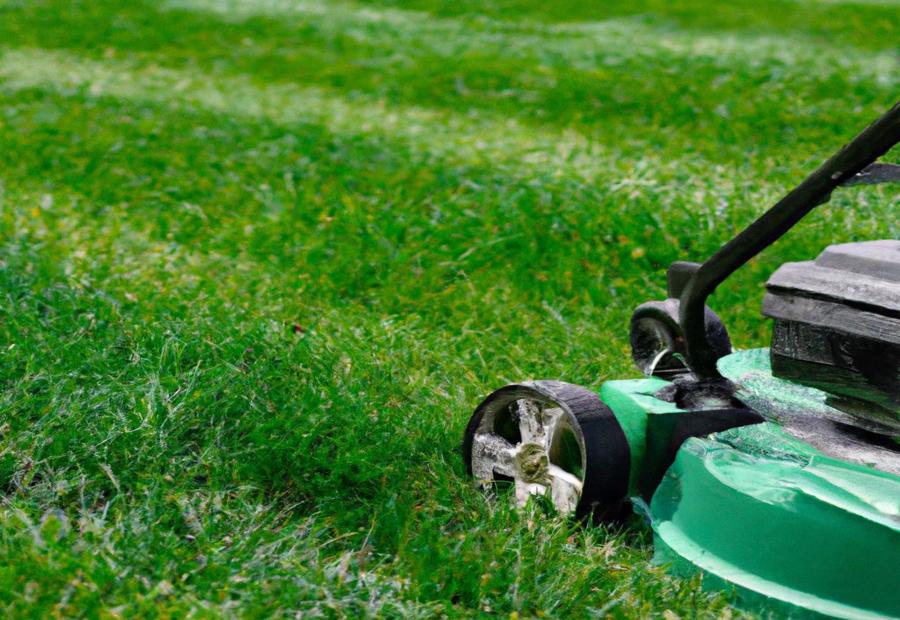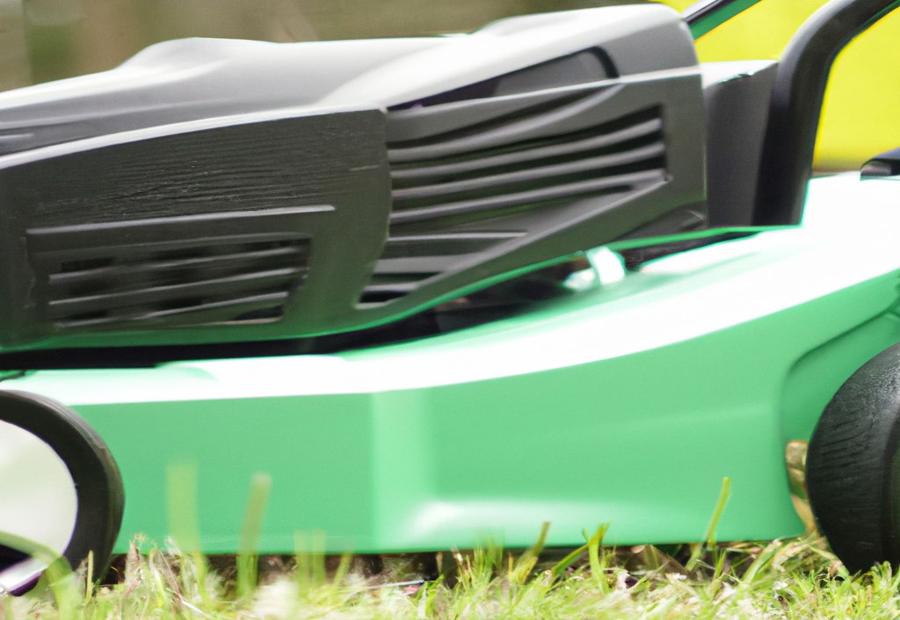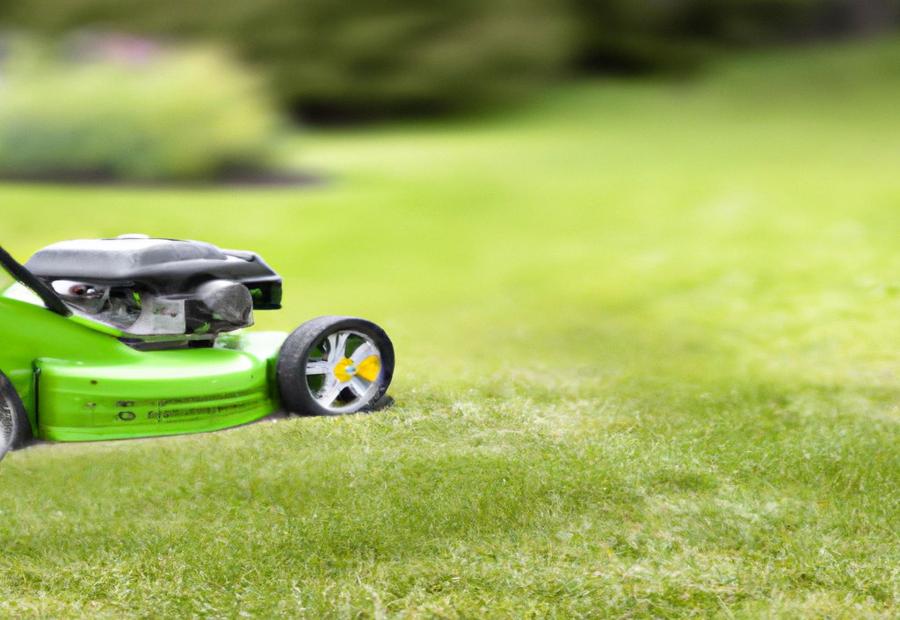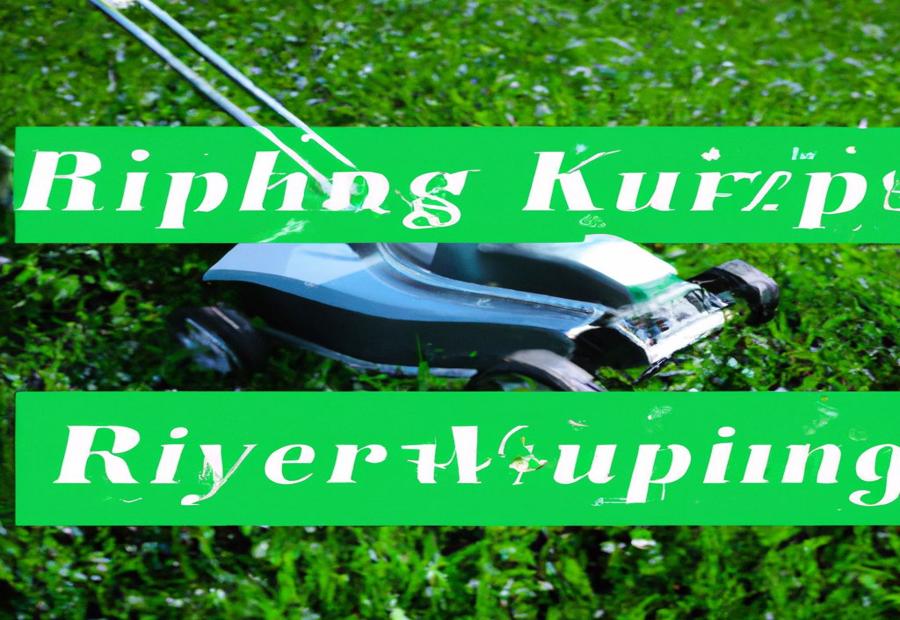GardenerHeaven.com is reader-supported. When you buy through links on our site, we may earn an affiliate commission.
.jpg)

Photo Credits: Gardenerheaven.Com by Arthur Robinson
Starting a push mower may seem like a simple task, but ensuring you do it right is essential. In this guide, we’ll explore the purpose and importance of properly starting a push mower. So, whether you’re a beginner or looking for a refresher, get ready to learn the quick and easy steps to kick-start your lawn care routine. Remember, a well-started mower is the key to a beautifully mowed yard.
Purpose of the Guide
A push mower is great for a neat lawn. But, starting it correctly is key. This guide will help beginners quickly and easily start a push mower.
First, pick the right one. Different types have various features and specs. Pick one suited to your lawn size.
Check fuel and gas before starting. Avoid mid-mow frustration by ensuring adequate supply.
Also, check oil levels. They help with performance and protect the engine.
Inspect blade condition. Dull or damaged blades can harm your lawn.
Clean and remove grass build-up from the underside of the deck. This stops clippings interfering with blade rotation.
Finally, find a safe spot to start the mower. Clear obstacles and make sure no one’s around.
Importance of Properly Starting a Push Mower
Starting a push mower is key! Doing it correctly ensures the engine runs smoothly. This reduces the risk of stalling or sputtering. It also helps prolong the mower’s life, avoiding wear and tear. Failing to start correctly may cause frustration and damage.
When beginning, make sure to follow the steps:
- Prime the engine by pressing the primer bulb multiple times.
- Pull the starter cord with a smooth, steady motion.
- Troubleshoot if mower doesn’t start – identify fuel blockages or spark plug issues.
Starting properly is not only beneficial for performance but also safety. Incorrect starting can lead to unexpected movements and malfunctions. Follow the steps to ensure a safe mowing experience. Before you start, make sure you’ve picked the right mower!
Preparing to Start a Push Mower

Photo Credits: Gardenerheaven.Com by Vincent Nelson
Preparing your push mower for a smooth start is essential for a hassle-free lawn maintenance experience. In this section, we’ll cover important steps that will help you get your push mower up and running quickly. From choosing the right push mower for your needs to ensuring fuel, oil, and blade conditions are checked, we’ll guide you through the necessary preparations. Plus, we’ll explain the importance of having your mower in a suitable location for safety and convenience. Let’s dive in and equip ourselves for a seamless mowing session.
Selecting the Right Push Mower
Pick the right push mower by figuring out your needs. Think about lawn size, terrain, power source, cutting width, and extra features. For small yards, a manual push mower is cheap and eco-friendly. But for bigger yards or rough terrain, a self-propelled one reduces strain and offers more maneuverability.
Choose between gas or electric. Gas-powered mowers are strong for large lawns. While electric ones are silent, need less maintenance, and fit smaller yards.
Also consider cutting width. Wider blades finish quickly, but may be hard to control in small spaces.
Lastly, look for features like adjustable cutting height, bagging or mulching options, and easy maintenance. These will make your life easier.
In the end, think about your needs and you’ll be sure to pick a push mower that fits you perfectly.
Checking Fuel and Gas Levels
Checking the fuel and gas levels is essential for starting a push mower properly. Doing this helps avoid stalling or stopping during use. Neglecting this can lead to delays and interruptions. Here’s how to check fuel and gas levels:
- Find the fuel tank: It’s usually near the back of the mower, either on top of or behind the engine.
- Take off the fuel cap: Carefully remove the cap to access the tank.
- Check for enough fuel: Look inside the tank and see if it’s at least halfway full.
- Refuel, if needed: If the tank is not at the right level, fill up with fresh gasoline until it reaches the appropriate level.
- Check gas levels: Make sure there’s enough gas to power the engine.
- Put the cap back on: Make sure it’s tightly sealed when done.
Using high-quality gasoline can improve performance and reduce potential issues. Read the manual for extra instructions or recommendations about fuel and gas.
Maintenance also includes regularly checking and refilling oil level and air filter. Use the manufacturer’s recommended type and weight for the oil.
Clean the blade before each use. Scrape or wash the blade to remove grass or debris.
Regular maintenance extends a push mower’s lifespan. So, remember to check the oil levels before starting. A dry engine won’t cut it!
Checking Oil Levels
Before you use a push mower, it is important to check the oil levels. Here’s how:
- Find the oil dipstick. It is usually near the engine and has a colored handle. It may say ‘Oil’ or have an oil can symbol.
- Take out and clean the dipstick. Wipe it with a rag or paper towel. This removes dirt or debris that could affect the reading.
- Check the oil level. Put the dipstick in the tube. Pull it out. Look at the markings. Is the oil within the recommended range? If it is below the minimum mark, top it up. If it is above the maximum mark, drain some out with proper tools.
Note: Check the oil when the engine is cold and not running. Different mowers have different methods for checking and adding oil. Check the manufacturer’s manual for specific instructions for your model.
Poor maintenance of mower engines, like low or no oil levels, has caused damage and reduced performance over time. Checking and maintaining proper oil levels will help your push mower last longer and work better.
Inspecting Blade Condition
It’s important to inspect the blades of a push mower for optimal performance. Well-maintained blades give a cleaner cut and reduce strain on the engine, allowing for greater efficiency and longer life. Here’s how to make sure your blades are in good condition:
- Put the push mower on a flat, stable surface.
- Disconnect the spark plug wire.
- Look for damage, such as cracks or nicks. If needed, replace the blades.
- Run your finger along the cutting edges to check for wear or dullness. If it’s rough or won’t make a clean cut, sharpen or replace the blades.
- Remove any grass clippings or debris with a brush or cloth.
- Connect the spark plug wire when done.
Inspect blades regularly, ideally before each use. This will ensure better cutting performance and safety. It only takes a few minutes and will help your push mower last longer and give you a professional-looking lawn. So don’t forget to inspect your blades!
Cleaning and Removing Grass Build Up
Cleaning and removing grass build up is a must for a push mower. Clippings over time can clog the mower’s deck and stop it working. So, to keep the mower in tip-top condition, follow these 4 steps:
- Turn off the engine and disconnect the spark plug wire.
- Use a brush or scraper to remove any loose grass clippings from the underside of the cutting deck.
- Unscrew the cutting blade from the spindle or use tools. Follow safety precautions.
- Clean the cutting blade and the inside of the cutting deck with a brush or hose. Remove all grass build up.
Cleaning and removing grass build up not only improves performance but also stops rusting and clogged debris damage, extending the life of the mower. Cleaning after each use is important for optimal performance. Following these steps helps maintain the mower and extend its lifespan.
Not cleaning and removing grass build up can cause big issues – decreased cutting, reduced engine performance, blade damage and complete engine failure. User manuals provide proper cleaning techniques to avoid future problems. It’s critical to understand how important regular cleaning is.
Finding the right spot to mow, where it won’t cause neighborly strife or random crop circles, is also essential.
Ensuring the Mower is in a Suitable Location
It’s key to pick a good spot for your push mower. Here are some things to consider:
- Ground: Find level, firm ground. Otherwise, it could tip over.
- Clear Area: Remove any obstacles or debris. They can get in the way or even cause harm.
- Ventilation: Place the mower in an open area with lots of air. This stops exhaust fumes from building up.
- Fire: Keep away from flammable materials, like gasoline, oil, or dry vegetation. This decreases the risk of a fire.
Also, make sure the spot is close to:
- Fuel and oil refill points
- Power outlets (if the mower has electric start)
Safety is key. Place the mower correctly and you’ll enjoy mowing more. Before you start, take a look around and remove any hazards. This will help keep you safe.
Step-by-Step Guide to Starting a Push Mower

Photo Credits: Gardenerheaven.Com by Walter Carter
In this step-by-step guide, we will walk you through the process of starting a push mower. From priming the engine to troubleshooting a no-start situation, we’ve got you covered. Follow along to learn the necessary steps and find additional resources and video help to ensure a smooth and successful start every time. Let’s get your push mower up and running with ease!
Priming the Engine
Before starting a push mower, priming the engine is essential. This process involves preparing the fuel to reach the combustion chamber. You can ensure easy starting by priming the engine and providing enough fuel.
To do this:
- Find the primer bulb. It’s usually red or black and close to the carburetor.
- Press and release the bulb with your thumb or fingers several times. This will push fuel into the carburetor.
- Check the clear tube (if applicable) to make sure there’s enough fuel.
Different models have different priming systems, so always consult the manual. It’s recommended to prime the engine before each start-up, especially if it hasn’t been used for a long time. This will guarantee the fuel is ready and the engine won’t be overworked.
Pulling the Starter Cord
Begin a push mower by pulling the starter cord. This starts the engine and lets the mower work. Follow these tips to pull the cord:
- Put the mower on level ground.
- Be safe – wear the right gear.
- Grip the handle, feet firmly planted.
- Reach down and grab the cord handle.
- Pull up quickly and firmly to start the engine.
If the mower does not start, more troubleshooting may be needed. Do the steps carefully to minimize any problems and start the mower. If it does not start, it can be very annoying.
Troubleshooting a No Start Mower
Troubleshooting no-start mowers? Here are six key steps to consider when resolving common issues related to starting difficulties:
- Check fuel and gas levels. Refuel if they’re low.
- Inspect blade condition. Replace or sharpen it if needed.
- Clean and remove grass build-up from engine and cutting deck.
- Prime engine by pressing and releasing primer bulb several times.
- Pull starter cord firmly, with a smooth and continuous motion.
- Check spark plug for signs of damage or fouling. Clean or replace it.
Always prioritize safety when dealing with machinery and hazardous materials. Additional help may be necessary.
Additional Resources and Video Help
Our guide provides extra resources and video support to help beginners start a push mower without difficulty. We offer:
- A tutorial video with a visual guide for the process
- A PDF manual with info on startup and maintenance
- Online forums and discussion boards
- Apps for iOS and Android with interactive guides
- Manufacturer websites with instructional videos and customer service.
For more detailed knowledge on push mower maintenance and troubleshooting, there are other online resources. They give special insights into common issues like engine troubles or blade upkeep. These can be helpful for those who want to improve their understanding of push mower operation.
One person posted about their experience on an online forum. They had trouble starting a push mower, so they watched a video from our recommended resource page. This revealed they had skipped a key step in priming the engine. After correcting this, they got the mower started without any further issues. This shows how useful extra resources and video help can be when facing push mower startup challenges.
Safety Precautions and Tips

Photo Credits: Gardenerheaven.Com by Bradley Garcia
When it comes to starting a push mower, safety should always be a top priority. In this section, we’ll explore essential safety precautions and tips to ensure a secure mowing experience. From the importance of wearing safety gear and appropriate clothing to operating the push mower safely and handling potentially hazardous materials like fuel, these guidelines will help beginners navigate the potential risks associated with this task. Stay informed and protect yourself as we break down the necessary precautions step by step.
Safety Gear and Clothing
Safety gear and clothing are must-haves for push mower operators! To stay safe, it’s important to don the right protective gear and clothing. Such include:
- Protective eyewear – safety goggles or glasses, to stop debris, grass clippings, or objects from getting in your eyes.
- Hearing protection – earplugs or earmuffs for loud mower noise.
- Gloves – better grip on the handles and to avoid blisters or cuts.
- Long pants and closed-toe shoes – durable material and slip-resistant soles, to prevent injuries from flying debris or contact with mower blades.
- Reflective clothing – enhance visibility and help stop accidents in low light.
Make sure all gear fits perfectly and is in good condition. Check and replace damaged items often for best protection.
Prioritize safety first! Wear the right protective gear and clothing, and reduce the risk of injuries. Be safe, for a smoother mowing experience.
Operating the Push Mower Safely
-
Before starting a push mower, wearing proper safety gear and clothing is essential. This includes closed-toe shoes, long pants, goggles, and hearing protection if needed. Protective gloves are also recommended.
-
Familiarize yourself with the mower’s controls and features before use. Know how to stop the engine quickly in an emergency and where all safety mechanisms are located.
-
When operating the push mower, keep a firm grip on the handlebars. Keep your hands and feet away from the rotating blades. Don’t remove or disable any safety guards or features.
-
Be watchful of your surroundings. Check for obstacles such as rocks and debris that could be thrown. Be cautious when approaching slopes or uneven terrain.
-
Follow these guidelines for safe use of a push mower and reduce the chance of accidents or injuries. Follow manufacturers’ instructions for specific models and variations. Always be aware and take appropriate precautions.
Handle fuel and hazardous materials safely — safety is just a spark away!
Handling Fuel and Other Hazardous Materials
When dealing with fuel and other hazardous materials, caution must be taken to ensure safety. Knowledge and understanding of handling these substances is essential for minimizing risks.
For push mowers, safety guidelines must be followed:
- Store fuel in approved containers, away from heat and open flames.
- Use a funnel when refueling to avoid spills.
- Clean up spills immediately.
- Refuel in a well-ventilated area – outdoors if possible.
Oil levels must also be checked regularly. Dispose of used oil properly; it can be harmful to the environment if not handled correctly. Follow manufacturer’s recommendations for selecting oil. Store it in a sealed container.
Protective gear such as gloves and goggles must be worn when handling other hazardous materials associated with push mowers – cleaning agents or chemicals for blade maintenance, etc. Follow instructions provided by the manufacturer for safe use and storage.
Safety must be prioritized when handling fuel and hazardous materials. By following correct procedures, accidents can be prevented, creating a safer working environment.
OSHA states that mishandling flammable liquids, such as gasoline, can cause fires leading to severe injuries or even death if not handled properly.
Conclusion

Photo Credits: Gardenerheaven.Com by Alan Brown
Starting a push mower? Keep these safety tips in mind!
- Firstly, make sure you have enough fuel and oil.
- Connect the spark plug and engage the blade control.
- Pull the starter rope with a firm & steady motion. If it doesn’t start on the first pull, repeat it.
- Lastly, adjust the throttle as needed.
Now, you’re ready to mow! Follow these steps and you’ll have a neat, well-maintained lawn in no time.
References

Photo Credits: Gardenerheaven.Com by Eugene Anderson
This section provides references related to the article titled “How to Start a Push Mower: Quick and Easy Guide for Beginners.” It has an informative, professional tone.
The reference data provides a comprehensive guide on how to start a push mower. It offers step-by-step instructions for beginners to understand the process easily. It serves as a quick reference for those without any prior experience. It also offers valuable tips and techniques to ensure a safe and hassle-free starting process.
Moreover, the data covers unique details not mentioned before. It helps beginners understand the various types of push mowers and their specific starting mechanisms. With this knowledge, they can choose the right type and apply the correct starting method.
To ensure successful starting, one can prime the engine by pushing the primer bulb firmly. This improves the fuel flow. Cleaning the air filter also ensures proper airflow and better performance. Regularly checking and replacing spark plugs enhances ignition efficiency, aiding in a smooth start. These suggestions are based on the information provided in the reference data.
Some Facts About How to Start a Push Mower: Quick and Easy Guide for Beginners:
- ✅ Push mowers are a more efficient and affordable option for maintaining small lawns compared to large, gas-guzzling lawn mowers. (Source: Team Research)
- ✅ There are three types of push mowers: manual push mowers, gas-powered push mowers, and electric push mowers. (Source: Team Research)
- ✅ Manual push mowers are the simplest and most traditional type, requiring physical effort from the user to operate. (Source: Team Research)
- ✅ Gas-powered push mowers are suitable for medium to large lawns with uneven terrain and thick grass. (Source: Team Research)
- ✅ Electric push mowers are suitable for small to medium-sized lawns and produce no emissions. (Source: Team Research)
FAQs about How To Start A Push Mower: Quick And Easy Guide For Beginners
How do I start a push mower?
Starting a push mower is a simple process. First, check the oil and gas levels to ensure they are sufficient. If your mower has a gas tap, make sure it is turned on. If it has a choke, turn it on or press the primer bulb three times. Engage the bail lever and pull the cord sharply to start the engine.
What factors should I consider when choosing a push mower?
When choosing a push mower, consider the size and terrain of your lawn, the type and thickness of grass, maintenance requirements, your budget, and the noise level. These factors will help you make an informed decision and select the ideal push mower for your needs.
Which type of push mower is best for a small to medium-sized lawn?
For small to medium-sized lawns with even terrain and short grass, electric push mowers are an ideal choice. They are quieter than gas-powered push mowers, produce no emissions, and are suitable for maintaining smaller lawns efficiently.
What are some top push mower brands and models available in the market?
Some top push mower brands and models include the Honda HRX217VKA gas-powered push mower, the Black+Decker CM2040 cordless electric push mower, and the Fiskars 18-Inch StaySharp Max Reel Mower. These trusted brands offer reliable and efficient push mowers for various lawn maintenance needs.
How do I troubleshoot common starting issues with a push mower?
If you’re having trouble starting your push mower, there are a few common causes to check. Ensure the fuel is fresh and of good quality. If the issue persists, cleaning the carburetor may be necessary. You can also watch a helpful video on “Common causes of a no start mower” for step-by-step troubleshooting guidance.
Are reel mowers an eco-friendly solution for small lawns?
Yes, reel mowers, which are manual push mowers, are an environmentally friendly option for small lawns. They require physical effort, produce no emissions, and are quiet. Reel mowers are suitable for small lawns with thin, fine grass and offer an eco-friendly alternative for lawn maintenance.




